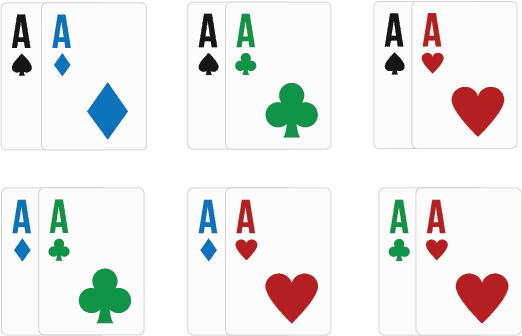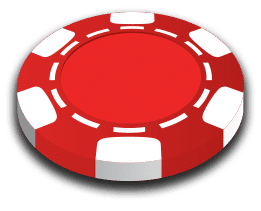I left a popular internet poker forum for good in 2006, and with a few exceptions here and there, I haven’t really participated in a poker forum in eight years. It’s extremely refreshing to get back into it on the Red Chip Poker forums, which so far, have been a delightful place to talk about poker hands.
I’ve noticed a few things in the month or so that I’ve been reading all the conversations and posting about hands. I figured I’d post my thoughts, quick-hit style.
We mostly all need combinatorics work
Combinatorics form the base framework for poker probabilities. In case you don’t know what combinatorics is, basically it’s counting. More specifically, it’s the practice of counting up all possible hand combinations to estimate probabilities and frequencies.
Here’s a simple example. Let’s say someone 3-bets preflop and you call. You think this player would 3-bet with T-T or better and A-Q or better. The flop comes Q-4-2. What is the chance this player has top pair or better?
You can solve exactly for the answer, given the assumptions.
First, we know that the player 3-bet preflop, and we assume that he would do it with any of the listed hands and no other. A hand A-A actually represents 6 different possible hands: AcAs, AcAd, AcAh, AsAd, AsAh, and AdAh. In general, a pocket pair can be made one of 6 different ways.

Suited hands like A-K suited can be made one of four ways (once for each of the four suits). Unsuited hands like A-K unsuited can be made one of twelve ways (each of the four suits can be paired with each of the three suits that are different—4 x 3 = 12).
There are five pocket pairs in the 3-bet range (aces through tens), two suited hands (A-K suited and A-Q suited), and two unsuited hands (again, A-K and A-Q). This makes 30 combinations of pocket pairs, 8 combinations of suited hands, and 24 combinations of unsuited hands. This makes 62 total possible combinations.
From this result, you can calculate the chance the player has any one single hand. A-A, for instance, is a 6/62 = 0.097 = 9.7% chance.
But these results hold only preflop. When the flop comes Q-4-2, the numbers change, because one of the queens is on the board. This fact reduces the number of possible combinations of Q-Q, A-Q suited, and A-Q unsuited.
When you remove one of the queens, you cut the number of Q-Q combos from 6 to 3. The number of suited combos of A-Q drops from 4 to 3. And the number of unsuited combos of A-Q drops from 12 to 9. Thus, on this flop, there are 55 total possible combinations.
How many of these are top pair or better? These hands are A-A, K-K, Q-Q, and A-Q suited and unsuited. There are 6 combos each of aces and kings. There are 3 of queens, 3 of A-Q suited, and 9 of A-Q unsuited. This makes 27 combos out of the 55 possible.
The chance this player has top pair or better, therefore, is 27/55 = 0.49 = 49% chance. This player is actually a slight underdog to have top pair or better on this flop, even with the premium preflop hand range.
Combinatorics analysis is useful in many poker situations. There was a hand on the forum where a player had 9-8 suited and the flop came Q-J-T. Holding the third-nuts, the chorus of feedback on the hand was to ship stacks. If you run into a better hand, that’s just how it goes.
However, I thought it was a tougher decision than that, and I used combinatorics analysis to justify my point. The stacks were very deep (200 big blinds), and the pot was relatively small on the flop. The opponent in question had all 16 possible combinations of A-K in play, and I felt like K-9 suited (4 combos) was also a possibility.
Additionally, it wasn’t clear how weak a hand the other player would play for stacks with. Certainly sets, but with 3 combos of these, that’s only 9 combos. Two pair combos, flush draw combos, and top pairs were also possible. But, regardless, a quick analysis of the relevant combinatorics would reveal that even though the bottom end of the straight was the third-nuts, it was worth a second look before just shipping it.
Equity calculators implicitly use combinatorics when they do their calculations. But it’s worth it to learn to do some of the math in your head as well, since you can’t use an equity calculator at the table. Often ranges are narrow enough that you can draw meaningful conclusions about probabilities and frequencies even in the heat of the moment.
You guys like to think outside the box
One thing I’ve really liked is that many players are willing to consider outside the box ideas. I recall a hand where someone tried a river bluff-raise that didn’t work. Ultimately I didn’t think it was quite the right spot for the play, but it’s much, much better to search for these opportunities than simply to pretend that they don’t exist.
When you’re posting hands, think about posting a hand where you didn’t make a crazy play—but where you wonder if one might be possible. I believe the majority of plays that I make that deviate from what a typical regular player would do are bluffs. It’s definitely worth it to mine the depths of possibility and at least consider making the “crazy” play that’s available to us on nearly every hand.
Keep posting
So far, the quality of discussion has been terrific. The coaches are commenting on nearly every hand posted. But you shouldn’t just take our word as final. And you don’t—members of the community are active on every hand, hashing things out.
It’s really a terrific atmosphere to talk about hands. And with a great signal-to-noise ratio at the moment, posting and discussing hands on the forum may be one of the best things you can do to get better quickly at this game.
Back in 2001, I put my first $100 on an online site. I didn’t know the first thing about poker. I read a book. Then I started posting hands on a forum. Back then, signal-to-noise was pretty good on the forum I used, and I got better very fast. Not too much longer after that, I had quit my job and was playing full-time. I built most of my knowledge from interacting with others, talking about hands on the forum.
This Red Chip Poker forum reminds me of those days. It’s a great resource. Post a hand today.

